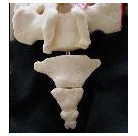One complication of surgical tailbone removal (coccygectomy) is that infection may occur at the surgical site.
Part of the reason for the relatively high likelihood of infection at this surgical site (compared with others) is that the coccygectomy site is so close to the anus.
Superficial infections can happen at the skin, which is called cellulitis.
Much more problematic are deep infections within the remaining bones. Bone infection is called osteomyelitis. When there is an infection within the bone, this can sometimes smolder in the background, unrecognized for many weeks or multiple months. Because the bone is deeper than the skin, it may not be immediately obvious that there is an infection.
Symptoms may include persistent or recurrent fevers, chills, ongoing pain at the site of the bone infection.
Blood work: Medical tests for tailbone infections may include blood work, looking for:
- elevated white blood cells,
- elevated erythrocyte sedimentation rate [ESR],
- elevated CRP,
- etc.
Imaging studies: Medical tests for tailbone infections may also include imaging studies, such as:
- x-rays,
- MRI,
- CT scans,
- nuclear medicine bone scans,
- etc.
Treatment typically includes a much more aggressive course of antibiotics, such as:
- giving the antibiotics intravenously (IV),(instead of by mouth)
- and giving these antibiotics for several weeks instead of just for several days.
Regarding complications and side-effects from coccygectomy (surgical removal of the tailbone), please click on the links below:
- Tailbone Removal (Coccygectomy): Drains, Antibiotics
- Bone infection after tailbone removal surgery (coccygectomy)
- Pain and Pelvic Floor Prolapse after Coccygectomy (Tailbone Removal)
- Pelvic Floor Prolapse (Sagging) after Coccygectomy
- Tailbone wounds that will not heal
- Painful Sex after Coccygectomy for Tailbone Pain?
- Coccygectomy: Expected Recovery and Return to Work after surgery for coccyx pain, tailbone pain. - November 28, 2023
- PRP Platelet Rich Plasma or Prolotherapy for Tailbone Pain, Coccyx Pain - October 25, 2023
- Reasons for Normal X-rays and MRI Despite Tailbone Pain, Coccyx Pain - October 3, 2023


[…] More info. on bone infections after coccygectomy. […]
i have now this pilonidal on my butt crack.its very pafniul and full of puss.even i cant walk,sit.please give me tips to cut off this.
if you have a pilonidal cyst with pain and pus coming out, then definitely you should be evaluated in person by a physician. I definitely do not recommend trying to cut this off yourself!
I do not perform coccygectomy (surgical removal of the tailbone) myself, since instead I focus on nonsurgical pain management treatments for tailbone pain.
However, approximately one out of every 30 or 40 patients who I see for tailbone pain fail to get adequate relief from nonsurgical treatments, and I sometimes do send those select minority of patients for surgical consultation.
Many do well with surgery, but it is a long recovery time with a high rate of infection and a high rate of need for repeat surgery, and, as both of you have unfortunately discovered some patients do not do well with surgery at all.
My heart goes out to those who suffer with ongoing pain.